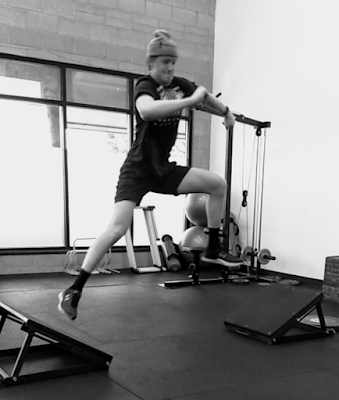Talking Legs & Strength
Over the next few days, Martin Bingisser will be sharing a video lesson and several articles related to programming for leg strength. James Marshall wrote a great piece -- "Training the Legs Through Movement" -- that was featured last week. Donie Fox and I will have follow up articles in the next few days that build on this idea.
In preparation for the video lesson discussion, Martin sent out some questions. I thought it would be good for me to write out my thoughts and take some time to reflect. Here are my thoughts on two of the questions. I hope my reflections spark your curiosity and direct you to the article by James and the follow up articles that will appear later today and this week.
Sorry for the wacky formatting. I have been trying to get it all neat and tidy, but Blogger has not cooperated with me today. So I'm playing with it all right now.
 |
| Alpine ski racer Cooper Iacobelli explores the Russian boxes. |
One point both James and Donie have made in their articles: there are some workouts that are made for loading, and others that are made for developing movement. Can we do both? Why? Why not?
You must learn to value and use both -- and that’s where developing a system comes in. You must decide which works best, how and why. Loaded and unloaded movements must compliment each other within a system. And HOW you load matters. The sum of their parts must be ATHLETICISM -- which is an emergent property and a much more complex quality than “strength.” The end goal isn’t simply a bigger 1 RM back squat.
Movement,
in and of itself, is a valuable tool. See
gymnastics, martial arts and many of the events in track and field. Triple
jumpers!!! Movement builds body awareness, mobility, joint/tissue integrity,
coordination, neuromuscular control -- all of the elements of foundational
infrastructure. Like James says: Work = Force x Distance. For many,
accelerating the mass of the body is quite enough force to handle and then
moving it greater distances, is a valuable, productive task.
Individually measured elements of “power” and “strength” -- developed in isolation and trained with very specific methods (power cleans) may not always carry over or support general movement, skill and coordination.
External load, in and of itself, may not be valuable. It might be meaningless because the movement has been so dumbed-down. It may even be detrimental or harmful. This is something many coaches struggle to see. When load reduces movement quality, or turns it into a stupid human trick, you must be prepared to reduce the load or eliminate the exercise.
Lightly-loaded (relative to bodyweight) movements can often be very valuable -- pause front squats at bodyweight or 50% of bodyweight, work set of 5 x 3; back squats at 80% of a "3 Rep sort of heavy set" for 6 x 3 on 1 min clock. Finding value in not loading barbell movements that are traditionally loaded very heavy is a hard sell. But I have made that transition because I value the movements in and of themselves. And I live by the wisdom of Kelvin Giles: “Deliver the foundations of mechanical efficiency, consistency and resilience.” This is the content I’m here for. And yes, bro, we lift. But more importantly, we actually MOVE the loads we lift with purpose, speed and grace.
----
How strong can you get without heavy loads? Which begs the question, what is strong . . . so we can talk about strength in traditional terms and then real strength.
Right. It all depends on how you define strength. And most people define it VERY narrowly, which is a shame. The blind pursuit of a 1 RM back squat and 2x-bodyweight back squat are the biggest obstacles to people using unloaded and lightly-loaded movements.
But you can get fit, healthy and capable without heavy loads. You can even win gold medals without a care in the world about a 1 RM back squat or clean. Eric Heiden won five gold medals in Lake Placid, in speed skating, without any big barbell training (personal communication with him). I don’t think anyone would say he wasn’t a “strong” athlete.
Gymnasts and martial artists get very strong in particular ways without doing “traditional strength” work. If strength is only defined as the ability to move an absolute external load, one time, then that fails to consider many important elements of human function. It is a very limited definition of intensity and effort.
Anyone who has done 5 full Leg Circuits or 5 full Spectrum Squats with only 30% of bodyweight can tell you there is a very high level of intensity and effort here. And when that type of effort is trained consistently, with good density (density within a workout, within a week, within a year, over years) you get a type of foundational work capacity and strength that is invaluable. But if you try to assess or express it with traditional strength tests, these tests may not fully capture that capacity.
So we must work to find additional definitions and methods to assess this type of “strength.” And broaden our definition to include other types of effort and intensity. Then more professionals will embrace these methods and see movement in and of itself as valuable -- and free themselves from the cult of heavy.
 |
| Professional Ironman triathlete Lauren Brandon works squat jumps in her 1/2 Leg Circuits. |

Comments